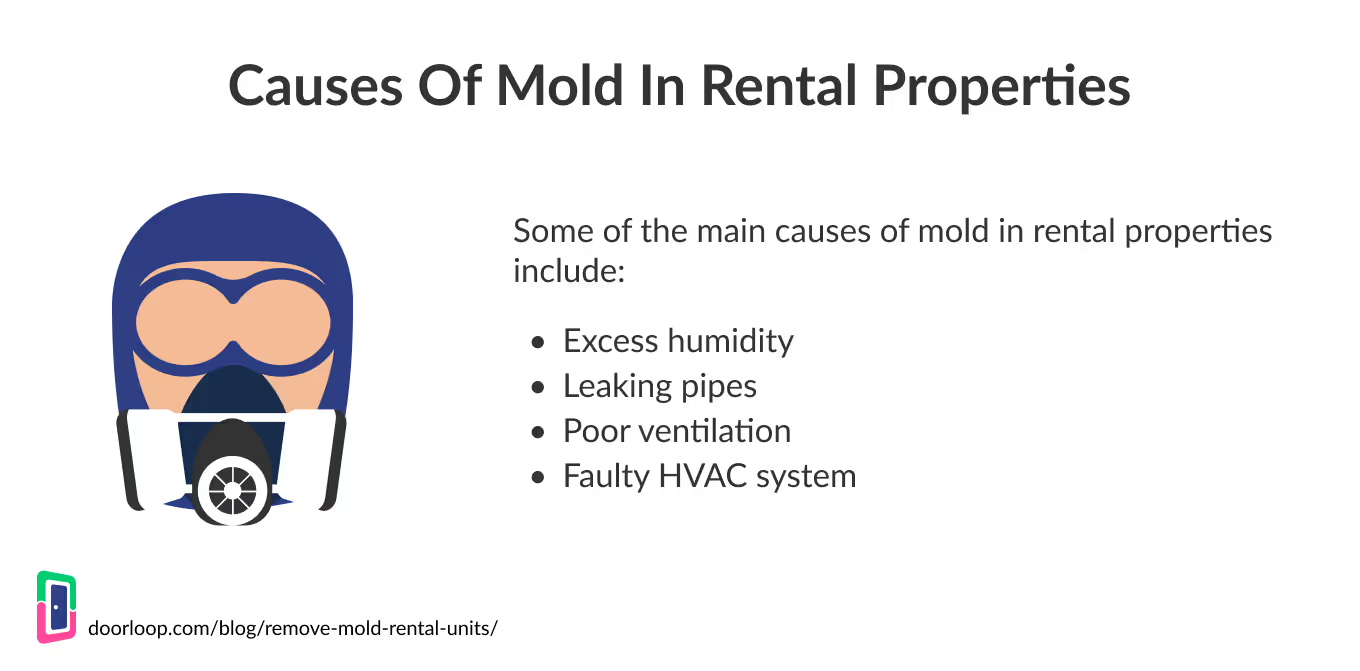Having mold in your rental units can lead to a plethora of problems.
Not only does it reduce the value of your property, but it also poses health problems for tenants.
This is why it is extremely important to keep your rental property clean and dispose of it as soon as possible.
But, as a property manager, this can seem like a difficult task. This is where we come in.
In this guide, we will be going over the complete process of mold removal, including how to prevent it and how to spot it.
To begin, let's go over some of the causes of mold and how to tell if it is present.

Where Does Mold Come From?
In short, mold is a type of fungi that grows in a natural environment. Unfortunately, when a rental unit has high levels of moisture or humidity, it becomes a breeding ground for mold. The mold then produces what is called mold spores, which are microscopic cells that travel through the air.
These tiny organisms spread the toxic mold throughout the entire property, especially through the HVAC system. Then, it becomes very difficult to prevent mold exposure. However, there are many different ways that mold can begin to grow in the first place. Below, we have provided a list of some of the common causes of mold growth in a rental property.
Causes Of Mold
If a rental property has a mold problem, then it most likely has some sort of other problem as well. Some of the causes of mold problems include:
- Excess moisture
- Very humid environment
- Leaking pipes/Leaking roof
- Poor ventilation
- Faulty air conditioner
Notice how a lot of these have to do with the overall environment of the property. For example, excess moisture and humidity are the most common causes of mold. But, these are caused by other external factors, like the environment in the specific state.
However, living in very humid climates does not guarantee mold. So, you should learn to pick up on some of the signs that a property has mold, discussed below.
Signs That A Property Has Mold
The best way to get rid of mold quickly is to catch it at the beginning. That is why it is super important to know what signs of mold to look out for in a rental property.
Some of the clearest signs of mold in your rental property include:
- A rotten smell
- Presence of visible mold
- Contaminated carpeting
- Warped walls
- Health issues
- Contaminated air filters
Knowing how to pick up on these signs of mold can make a big difference in how quickly it can be removed. However, since most of these signs do not include visible mold growth, it is important to test for it.
Testing for mold can help the property owners confirm the presence of mold, even with some of the signs. Below, we will be discussing how to test for mold in your rental properties.
How To Test For Mold
The easiest way to tell if a property has mold is to test for it. Mold testing can be done by the property owner themselves or by a professional. If the owner or manager wants to test for mold themselves, there are a few different ways to do so.
One of the ways is to use a screwdriver or pointy object to probe moldy areas. If the walls in the area are soft or crumble under the screwdriver, there is probably mold and rot has begun. If not, there are many choices of at-home DIY test kits. These usually come with simple instructions and give you an easy answer to whether or not there is mold.
The last resort is to get a professional mold inspection. These are usually conducted when a property is being purchased to be 100% sure that there are no problems. Since it is not evident when mold grows, these inspections can come up with unexpected results.
So, let's say that one of your rental properties is being rented out by a tenant. Then, the tenant reports indoor mold growth. Who is responsible for cleaning this up? We will be answering that very question just below.

Who Is Responsible For Cleaning The Mold?
Claiming responsibility for cleaning up mold in a property is a big task. Depending on the severity of the growth, the repairs can cost thousands of dollars. Below, we will be covering the process of determining who is responsible for the repairs, the landlord or the tenant.
State And Local Laws
The first thing that needs to be done before someone is named responsible is checking the state and local laws. Only a few states mention anything in their landlord-tenant laws about mold growth in the property. However, most mention things about providing a safe and habitable environment for their tenants.
This is why landlords are typically tasked with getting rid of the mold in rental properties. But, there may be some cases where the state law or local law states otherwise.
Landlord Responsibilities
If the mold infestation is reported by the tenant in a timely manner, it is the responsibility of the landlord to clean it up. This is especially true if the mold is causing respiratory problems or other health problems for the tenants.
The landlord's failure to remove the mold can lead to a variety of different things. If the tenants are suffering from severe health issues, the landlord can face a hefty lawsuit. The landlord can also face lost rent or the charges of property damage if the mold is left untouched.
Tenant Responsibilities
If mold growth is caused by tenant behavior, then the tenant can be held liable. For example, if there is a cleanliness clause in the lease agreement that the tenant does not follow, they may be held liable for all the charges of getting rid of the mold. This means that, even though a lack of a mold-free environment violates most state and local laws, it is the tenant's responsibility to get it fixed.
Now, no matter if it is the tenant's fault or the landlord's fault, it is time for some mold remediation. Removing mold is not easy, especially if it is black mold. But, there are some things to try before calling in the professionals. Below, we have outlined some of the best ways to remove mold from a rental property.

How To Remove Mold In Rental Properties
Removing mold from a property is no easy task. However, it can be done with some hard work and dedication. Below, we have outlined some of the steps that should be taken to remove mold from a rental property.
Moisture Control
The first step that needs to be taken is to control the moisture in the unit. Since the likely cause of the mold is excess moisture, fixing that problem first makes the rest of the process much easier. Some of the things to look out for when trying to fix this problem include:
- Cracks in the foundation
- Moisture on the floor
- Leaky pipes
..and other things that indicate excess moisture. To get rid of this moisture, you can run a dehumidifier in the area. This device sucks in the humid air and removes the moisture from it. This way, the area around it has much lower levels of moisture.
Discard Affected Drywall
After taking care of the moisture problem, it is time to take care of the actual mold. Since most mold is going to be located on some sort of drywall, that is where you are going to concentrate your efforts.
You can find the drywall that has been affected by poking around with a sharp object or by simply looking for dark spots on the walls. Once the affected area has been found, it should be scrubbed very heavily with some cleaning agent. Continue doing this until the wall is free of dark spots.
If this does not work, you may have to discard the piece of drywall completely. If the mold is this severe, it is likely that you will have to treat the framing as well.
Treat Wall Framing
If you had to remove moldy drywall, you will most likely have to treat the framing behind it as well. This mold can be removed by vigorously scrubbing at the framing until the dark spots go away.
After all of the mold has been scrubbed away, you can treat the wood with a mold abatement product. These products typically specialize in preventing mold growth and can help save you time and money in the future. After that, replace the drywall, and move on to any other spots that have mold.
Sanitize Affected Carpeting
Carpeting can be affected by mold in the same way that drywall is. If you find that your carpeting has been infected by mold, you can still save it before discarding it. If the mold is not established, the carpet can be washed with a solution of water and a cleaning agent to disinfect it.
After that, it is important that you set it out in the sun to dry. Make sure to leave it in the sun for long enough as it is harder for mold to grow in dry areas. To learn more about cleaning carpets in your rental property, visit DoorLoop's Full Guide On Deep Cleaning Carpets.
So, now that you see how difficult it is to get rid of mold, you probably want to know how to prevent it in the first place. Luckily for you, that is exactly what we will be covering in the next section.

How To Prevent Mold Growth In Rental Properties
Preventing mold can save property managers and tenants tons of time and money in the future. Below, we have explained some of the best ways to prevent the growth of mold in rental properties.
Conduct Routine Inspections
One of the best ways to prevent mold growth, and most other problems in your rental properties, is by routinely inspecting them. Routine inspections allow property managers to know exactly what is going on in the properties and quickly put an end to any problems.
There are, however, many limitations to rental property inspections in many states. To learn all about rental property inspections and how to do them correctly, visit DoorLoop's full guide on conducting a rental property inspection.
Fix All Leaks
As mentioned before, one of the most important things to do to prevent mold is to fix leaks. Since leaks make it easy for moisture to increase in a rental unit, it makes it much easier for mold to grow as well.
If you are having trouble finding a leak, or do not know how to fix it, it may be time to call the professionals. Depending on the location of the leak, you can either call a plumber, a roofer, or a carpenter.
Keep Humidity Levels Low
Keeping humidity levels low goes hand-in-hand with fixing leaks. Especially if you live in very humid climates, it may be worth it to install dehumidifiers in your rental properties. It is important to note, however, that the humidity cannot be too low either. Low humidity has as many consequences as high humidity.
If you follow all of these steps, your property will be free of mold in no time.
































.svg)
.svg)

